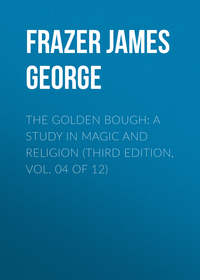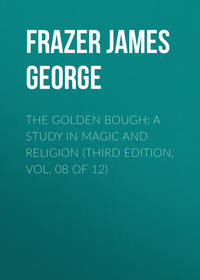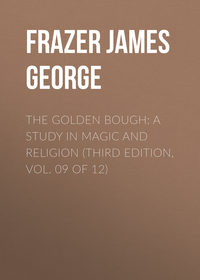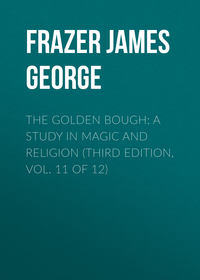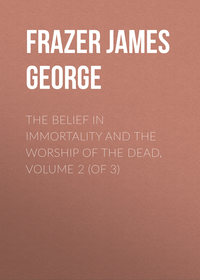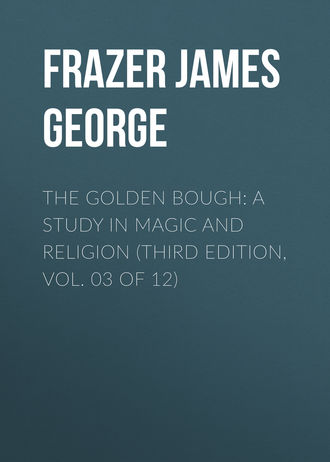 полная версия
полная версияThe Golden Bough: A Study in Magic and Religion (Third Edition, Vol. 03 of 12)
634
Reports of the Cambridge Anthropological Expedition to Torres Straits, v. 271 note.
635
R. E. Guise, “On the Tribes inhabiting the Mouth of the Wanigela River,” Journal of the Anthropological Institute, xxviii. (1899) p. 218. The account refers specially to Bulaa, which the author describes (pp. 205, 217) as “a marine village” and “the greatest fishing village in New Guinea.” Probably it is built out over the water. This would explain the allusion to the sanctified headman going ashore daily at sundown.
636
Captain F. R. Barton and Dr. Strong, in C. G. Seligmann's The Melanesians of British New Guinea (Cambridge, 1910), pp. 292, 293 sq.
637
W. H. Furness, The Island of Stone Money, Uap of the Carolines (Philadelphia and London, 1910), pp. 38 sq., 44 sq. Though the fisherman may have nothing to do with his wife and family, he is not wholly debarred from female society; for each of the men's clubhouses has one young woman, or sometimes two young women, who have been captured from another district, and who cohabit promiscuously with all the men of the clubhouse. The name for one of these concubines is mispil. See W. H. Furness, op. cit. pp. 46 sqq. There is a similar practice of polyandry in the men's clubhouses of the Pelew Islands. See J. Kubary, Die socialen Einrichtungen der Pelauer (Berlin, 1885), pp. 50 sqq. Compare Adonis, Attis, Osiris, Second Edition, pp. 435 sq.
638
J. S. Kubary, Ethnographische Beiträge zur Kenntnis des Karolinen Archipels (Leyden, 1895), p. 127.
639
W. Crooke, Popular Religion and Folk-lore of Northern India (Westminster, 1896), ii. 257. In Chota Nagpur and the Central Provinces of India the rearers of silk-worms “carefully watch over and protect the worms, and while the rearing is going on, live with great cleanliness and self-denial, abstaining from alcohol and all intercourse with women, and adhering very strictly to certain ceremonial observances. The business is a very precarious one, much depending on favourable weather” (Indian Museum Notes, issued by the Trustees, vol. i. No. 3 (Calcutta, 1890), p. 160).
640
The Rev. J. Roscoe in letters to me dated Mengo, Uganda, April 23 and June 6, 1903.
641
Rev. J. Roscoe, “Further Notes on the Manners and Customs of the Baganda,” Journal of the Anthropological Institute, xxxii. (1902) p. 56.
642
Rev. J. H. Weeks, “Anthropological Notes on the Bangala of the Upper Congo,” Journal of the Anthropological Institute, xxxix. (1909) pp. 458, 459.
643
J. W. Thomas, “De jacht op het eiland Nias,” Tijdschrift voor Indische Taal- Land- en Volkenkunde, xxvi. (1880) pp. 276 sq.
644
J. Chalmers, Pioneering in New Guinea (London, 1887), p. 186.
645
P. Reichard, Deutsch-Ostafrika (Leipsic, 1892), p. 427.
646
See The Magic Art and the Evolution of Kings, vol. i. p. 123.
647
Mgr. Le Roy, “Les Pygmées,” Missions Catholiques, xxix. (1897) p. 269.
648
C. Lumholtz, Unknown Mexico, ii. 40 sq.
649
Father A. G. Morice, “Notes, Archaeological, Industrial, and Sociological on the Western Denés,” Transactions of the Canadian Institute, iv. (1892-93) pp. 107, 108.
650
M. C. Stevenson, “The Sia,” Eleventh Annual Report of the Bureau of Ethnology (Washington, 1894), p. 118.
651
Fr. Boas, in Tenth Report on the North-Western Tribes of Canada, p. 47 (separate reprint from the Report of the British Association for 1895).
652
Id., in Sixth Report on the North-Western Tribes of Canada, p. 90 (separate reprint from the Report of the British Association for 1890).
653
J. Teit, “The Thompson Indians of British Columbia,” Memoir of the American Museum of Natural History, The Jesup North Pacific Expedition, vol. i. part iv. (April 1900) p. 347.
654
J. Teit, op. cit. p. 348.
655
Washington Matthews, Ethnography and Philology of the Hidatsa Indians (Washington, 1877), pp. 58-60. Other Indian tribes also observe elaborate superstitious ceremonies in hunting eagles. See Totemism and Exogamy, iii. 182, 187 sq.
656
E. Aymonier, Notes sur le Laos (Saigon, 1885), p. 141.
657
P. Ch. Gilhodes, “La Culture matérielle des Katchins (Birmanie),” Anthropos, v. (1910) p. 622. Compare J. Anderson, From Mandalay to Momien (London, 1876), p. 198, who observes that among the Kakhyens (Kachins) the brewing of beer “is regarded as a serious, almost sacred, task, the women, while engaged in it, having to live in almost vestal seclusion.”
658
J. G. Frazer, Totemism and Exogamy, ii. 410 sq., on Mr. A. C. Hollis's authority.
659
M. Weiss, Die Völker-Stämme im Norden Deutsch-Ostafrikas (Berlin, 1910), p. 396.
660
G. A. Wilken, “Bijdrage tot de Kennis der Alfoeren van het eiland Boeroe,” p. 30 (Verhandelingen van het Bataviaasch Genootschap van Kunsten en Wetenschappen, xxxvi.).
661
J. G. F. Riedel, De sluik- en kroesharige rassen tusschen Selebes en Papua, p. 179.
662
G. H. von Langsdorff, Reise um die Welt (Frankfort, 1812), i. 118 sq.
663
G. H. von Langsdorff, op. cit. i. 117.
664
B. de Sahagun, Histoire générale des choses de la Nouvelle Espagne, traduite par D. Jourdanet et R. Simeon, p. 45.
665
H. A. Junod, “Les Conceptions physiologiques des Bantou sud-africains et leurs tabous,” Revue d'Ethnographie et de Sociologie, i. (1910) p. 148.
666
Dameon Grangeon, “Les Chams et leurs superstitions,” Missions Catholiques, xxviii. (1896) p. 70.
667
Father Lambert, “Mœurs et superstitions de la tribu Bélep,” Missions Catholiques, xii. (1880) p. 215; id., Mœurs et superstitions des Néo-Calédoniens (Nouméa, 1900), pp. 191 sq.
668
R. Parkinson, Dreissig Jahre in der Südsee (Stuttgart, 1907), p. 99.
669
Captain F. R. Barton, in C. G. Seligmann's The Melanesians of British New Guinea (Cambridge, 1910), pp. 100-102. The native words which I have translated respectively “skipper” and “mate” are baditauna and doritauna. The exact meaning of the words is doubtful.
670
Quoted by Dr. George Turner, Samoa (London, 1884), pp. 349 sq.
671
J. M. Hildebrandt, “Ethnographische Notizen über Wakamba und ihre Nachbarn,” Zeitschrift für Ethnologie, x. (1878) p. 401.
672
H. R. Tate, “Further Notes on the Kikuyu Tribe of British East Africa,” Journal of the Anthropological Institute, xxxiv. (1904) pp. 260 sq. At the festivals sheep and goats are sacrificed to God (Ngai), and the people feast on the roast flesh.
673
E. W. Nelson, “The Eskimo about Bering Strait,” Eighteenth Annual Report of the Bureau of American Ethnology, part i. (Washington, 1899) pp. 438, 440.
674
E. W. Nelson, op. cit. p. 440, compare pp. 380 sq. The bladder festival of these Esquimaux will be described in a later part of this work.
675
I. Petroff, Report on the Population, Industries, and Resources of Alaska (preface dated August 7, 1882), pp. 154 sq.
676
W. H. Dall, Alaska and its Resources (London, 1870), p. 404.
677
Fr. Boas, “The Central Eskimo,” Sixth Annual Report of the Bureau of Ethnology (Washington, 1888), pp. 584 sq., 595; id. “The Eskimo of Baffin Land and Hudson Bay,” Bulletin of the American Museum of Natural History, xv. part i. (1901) pp. 121-124. See also id. “Die Sagen der Baffin-land Eskimo,” Verhandlungen der Berliner Gesellschaft für Anthropologie, Ethnologie, und Urgeschichte (1885), pp. 162 sq.; id., in Proceedings and Transactions of the Royal Society of Canada, v. (Montreal, 1888) section ii. pp. 35 sq.; C. F. Hall, Life with the Esquimaux (London, 1864), ii. 321 sq.; id., Narrative of the Second Arctic Expedition made by Charles F. Hall, edited by Professor J. E. Nourse (Washington, 1879), pp. 191 sq.
678
That is, the wizard or sorcerer.
679
That is, the wizard or sorcerer.
680
Fr. Boas, “The Eskimo of Baffin Land and Hudson Bay,” Bulletin of the American Museum of Natural History, xv. pt. i. (1901) pp. 119-121, 124-126. In quoting these passages I have changed the spelling of a few words in accordance with English orthography.
681
Le P. P. Cayzac, “La Religion des Kikuyu,” Anthropos, v. (1905) p. 311.
682
Le P. P. Cayzac, loc. cit. The nature of the “ignoble ceremony” of transferring sin to a he-goat is not mentioned by the missionary. It can hardly have been the simple Jewish one of laying hands on the animal's head.
683
D. W. Harmon, in Rev. Jedidiah Morse's Report to the Secretary of War of the United States on Indian Affairs (New-haven, 1822), p. 345. The Carriers are an Indian tribe of North-West America who call themselves Ta-cul-lies, “a people who go upon water” (ibid. p. 343).
684
Francis C. Nicholas, “The Aborigines of Santa Maria, Colombia,” American Anthropologist, N.S. iii. (1901) pp. 639-641.
685
A. de Herrera, The General History of the Vast Continent and Islands of America, translated by Capt. J. Stevens (London, 1725-26), iv. 148. The confession of sins appears to have held an important place in the native religion of the American Indians, particularly the Mexicans and Peruvians. There is no sufficient reason to suppose that they learned the practice from Catholic priests. For more evidence of the custom among the aborigines of America see L. H. Morgan, League of the Iroquois (Rochester, U.S. America, 1851), pp. 170 sq., 187 sq.; B. de Sahagun, Histoire générale des choses de la Nouvelle Espagne, bk. i. ch. 12, bk. vi. ch. 7, pp. 22-27, 339-344 (Jourdanet and Simeon's French translation); A. de Herrera, op. cit. iv. 173, 190; Diego de Landa, Relation des choses de Yucatan (Paris, 1864), pp. 154 sqq.; Brasseur de Bourbourg, Histoire des nations civilisées du Mexique et de l'Amérique Centrale, ii. 114 sq., 567, iii. 567-569; P. J. de Arriaga, Extirpacion de la idolatria del Piru (Lima, 1621), pp. 18, 28 sq.
686
As to this means of hastening the delivery see Totemism and Exogamy, iv. 248 sqq. The intention of the exchange of clothes at childbirth between husband and wife seems to be to relieve the woman by transferring the travail pangs to the man.
687
G. Ferrand, Les Musulmans à Madagascar, Deuxième Partie (Paris, 1893), pp. 20 sq.
688
H. Oldenberg, Die Religion des Veda (Berlin, 1894), pp. 319 sq.
689
Satapatha Brahmana, translated by J. Eggeling, pt. i. p. 397 (Sacred Books of the East, vol. xii.).
690
The similarity of some of the Mosaic laws to savage customs has struck most Europeans who have acquired an intimate knowledge of the savage and his ways. They have often explained the coincidences as due to a primitive revelation or to the dispersion of the Jews into all parts of the earth. Some examples of these coincidences were cited in my article “Taboo,” Encyclopaedia Britannica,9 xxiii. 17. The subject has since been handled, with consummate ability and learning, by my lamented friend W. Robertson Smith in his Religion of the Semites (New Edition, London, 1894). In Psyche's Task I have illustrated by examples the influence of superstition on the growth of morality.
691
A. W. Nieuwenhuis, Quer durch Borneo, i. 106 sq.
692
J. Adair, History of the American Indians, p. 118.
693
C. J. Andersson, Lake Ngami, p. 224.
694
L. Alberti, De Kaffers aan de Zuidkust van Afrika (Amsterdam, 1810), pp. 158 sq. Compare H. Lichtenstein, Reisen im südlichen Africa (Berlin, 1811-12), i. 419. These accounts were written about a century ago. The custom may since have become obsolete. A similar remark applies to other customs described in this and the following paragraph.
695
P. Kolbe, Present State of the Cape of Good Hope, I.2 (London, 1738) pp. 251-255. The reason alleged for the custom is to allow the slayer to recruit his strength. But the reason is clearly inadequate as an explanation of this and similar practices.
696
J. Scheffer, Lapponia (Frankfort, 1673), pp. 234-243; C. Leemius, De Lapponibus Finmarchiae eorumque lingua, vita et religione pristina commentatio (Copenhagen, 1767), pp. 502 sq.; E. J. Jessen, De Finnorum Lapponumque Nouvegicorum religione pagana tractatus singularis, pp. 64 sq. (bound up with Leemius's work).
697
S. Kay, Travels and Researches in Caffraria (London, 1833), pp. 341 sq.
698
J. Duncan, Travels in Western Africa (London, 1847), i. 195 sq.; F. E. Forbes, Dahomey and the Dahomans (London, 1851), i. 107; P. Bouche, La Côte des Esclaves (Paris, 1885), p. 397; A. B. Ellis, The Ewe-speaking Peoples of the Slave Coast, pp. 58 sq.
699
Indian Antiquary, xxi. (1892) p. 224. Many of the above examples of expiation exacted for the slaughter of animals have already been cited by me in a note on Pausanias, ii. 7. 7, where I suggested that the legendary purification of Apollo for the slaughter of the python at Delphi (Plutarch, Quaest. Graec., 12; id., De defectu oraculorum, 15; Aelian, Var. Hist. iii. 1) may be a reminiscence of a custom of this sort.
700
Le R. P. Cadière, “Croyances et dictons populaires de la Vallée du Nguôn-son, Province de Quang-binh (Annam),” Bulletin de l'École Française d'Extrême Orient, i. (1901) pp. 183 sq.
701
On the nature of taboo see my article “Taboo” in the Encyclopaedia Britannica, 9th edition, vol. xxiii. (1888) pp. 15 sqq.; W. Robertson Smith, Religion of the Semites2 (London, 1894), pp. 148 sqq., 446 sqq. Some languages have retained a word for that general idea which includes under it the notions which we now distinguish as sanctity and pollution. The word in Latin is sacer, in Greek, ἅγιος. In Polynesian it is tabu (Tongan), tapu (Samoan, Tahitian, Marquesan, Maori, etc.), or kapu (Hawaiian). See E. Tregear, Maori-Polynesian Comparative Dictionary (Wellington, N.Z., 1891), s. v. tapu. In Dacotan the word is wakan, which in Riggs's Dakota-English Dictionary (Contributions to North American Ethnology, vol. vii., Washington, 1890, pp. 507 sq.) is defined as “spiritual, sacred, consecrated; wonderful, incomprehensible; said also of women at the menstrual period.” Another writer in the same dictionary defines wakan more fully as follows: “Mysterious; incomprehensible; in a peculiar state, which, from not being understood, it is dangerous to meddle with; hence the application of this word to women at the menstrual period, and from hence, too, arises the feeling among the wilder Indians, that if the Bible, the church, the missionary, etc., are ‘wakan,’ they are to be avoided, or shunned, not as being bad or dangerous, but as wakan. The word seems to be the only one suitable for holy, sacred, etc., but the common acceptation of it, given above, makes it quite misleading to the heathen.” On the notion designated by wakan, see also G. H. Pond, “Dakota Superstitions,” Collections of the Minnesota Historical Society for the year 1867 (Saint Paul, 1867), p. 33; J. Owen Dorsey, in Eleventh Annual Report of the Bureau of Ethnology (Washington, 1894), pp. 366 sq. It is characteristic of the equivocal notion denoted by these terms that, whereas the condition of women in childbed is commonly regarded by the savage as what we should call unclean, among the Herero the same condition is described as holy; for some time after the birth of her child, the woman is secluded in a hut made specially for her, and every morning the milk of all the cows is brought to her that she may consecrate it by touching it with her mouth. See H. Schinz, Deutsch-Südwest-Afrika, p. 167. Again, whereas a girl at puberty is commonly secluded as dangerous, among the Warundi of eastern Africa she is led by her grandmother all over the house and obliged to touch everything (O. Baumann, Durch Massailand sur Nilquelle (Berlin, 1894), p. 221), as if her touch imparted a blessing instead of a curse.
702
Plutarch, Agis, 19.
703
W. Ellis, Polynesian Researches,2 iii. 102.
704
E. Aymonier, Le Cambodge, ii. (Paris, 1901) p. 25.
705
J. Moura, Le Royaume du Cambodge (Paris, 1883), i. 226.
706
Ch. Dallet, Histoire de l'Église de Corée (Paris, 1874), i. pp. xxiv. sq.; W. E. Griffis, Corea, the Hermit Nation (London, 1882), p. 219. These customs are now obsolete (G. N. Curzon, Problems of the Far East (Westminster, 1896), pp. 154 sq. note).
707
Macrobius, Sat. v. 19. 13; Servius on Virgil, Aen. i. 448; Joannes Lydus, De mensibus, i. 31. We have already seen (p. 16) that the hair of the Flamen Dialis might only be cut with a bronze knife. The Greeks attributed a certain cleansing virtue to bronze; hence they employed it in expiatory rites, at eclipses, etc. See the Scholiast on Theocritus, ii. 36.
708
Acta Fratrum Arvalium, ed. G. Henzen (Berlin, 1874), pp. 128-135; J. Marquardt, Römische Staatsverwaltung, iii.2 (Das Sacralwesen) pp. 459 sq.
709
Plutarch, Praecepta gerendae reipublicae, xxvi. 7. Plutarch here mentions that gold was also excluded from some temples. At first sight this is surprising, for in general neither the gods nor their ministers have displayed any marked aversion to gold. But a little enquiry suffices to clear up the mystery and set the scruple in its proper light. From a Greek inscription discovered some years ago we learn that no person might enter the sanctuary of the Mistress at Lycosura wearing golden trinkets, unless for the purpose of dedicating them to the goddess; and if any one did enter the holy place with such ornaments on his body but no such pious intention in his mind, the trinkets were forfeited to the use of religion. See Ἐφημερὶς ἀρχαιολογική (Athens, 1898), col. 249; Dittenberger, Sylloge inscriptionum Graecarum,2 No. 939. The similar rule, that in the procession at the mysteries of Andania no woman might wear golden ornaments (Dittenberger, op. cit. No. 653), was probably subject to a similar exception and enforced by a similar penalty. Once more, if the maidens who served Athena on the Acropolis at Athens put on gold ornaments, the ornaments became sacred, in other words, the property of the goddess (Harpocration, s. v. ἀρρηφορεῖν, vol. i. p. 59, ed. Dindorf). Thus it appears that the pious scruple about gold was concerned rather with its exit from, than with its entrance into, the sacred edifice. At the sacrifice to the Sun in ancient Egypt worshippers were forbidden to wear golden trinkets and to give hay to an ass (Plutarch, Isis et Osiris, 30) – a singular combination of religious precepts. In India gold and silver are common totems, and members of such clans are forbidden to wear gold and silver trinkets respectively. See Totemism and Exogamy, iv. 24.
710
Callimachus, referred to by the Old Scholiast on Ovid, Ibis. See Callimachea, ed. O. Schneider, ii. p. 282, Frag. 100a E.; Chr. A. Lobeck, Aglaophamus, p. 686.
711
Plutarch, Aristides, 21. This passage was pointed out to me by my friend Mr. W. Wyse.
712
Theophilus Hahn, Tsuni-Goam, the Supreme Being of the Khoi-Khoi (London, 1881), p. 22.
713
Dr. P. H. Brincker, “Charakter, Sitten und Gebräuche speciell der Bantu Deutsch-Südwestafrikas,” Mittheilungen des Seminars für orientalische Sprachen zu Berlin, iii. (1900) Dritte Abtheilung, p. 80.
714
A. van Gennep, Tabou et totémisme à Madagascar (Paris, 1904), p. 38.
715
W. H. Furness, The Island of Stone Money, Uap of the Carolines (Philadelphia and London, 1910), p. 151.
716
J. G. Bourke, The Snake Dance of the Moquis of Arizona (New York, 1891), pp. 178 sq.
717
G. B. Grinnell, Pawnee Hero Stories and Folk-tales (New York, 1889), p. 253.
718
See above, pp. 205 sq.
719
E. W. Nelson, “The Eskimo about Bering Strait,” Eighteenth Annual Report of the Bureau of American Ethnology, Part I. (Washington, 1899) p. 392.
720
E. W. Nelson, op. cit. p. 383.
721
Fr. Boas, “The Eskimo of Baffin Land and Hudson Bay,” Bulletin of the American Museum of Natural History, xv. Part I. (1901) p. 149.
722
C. F. Gordon Cumming, In the Hebrides (ed. 1883), p. 195.
723
James Logan, The Scottish Gael (ed. Alex. Stewart), ii. 68 sq.




